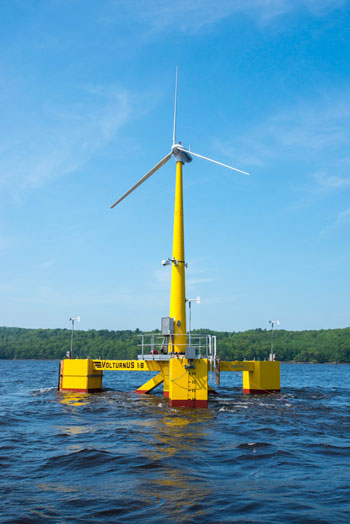Maine’s Offshore Wind Past First Phase

UMaine Offshore Wind project 1/8 scale model off Dice’s Head, Castine. Installed in June 2013, the hollow concrete floating base is anchored to the bottom with drag anchors. The tower and blades are lightweight fiberglass. UMaine Photo
The offshore wind project based at the University of Maine at Orono has passed the first of three phases. Phase one is planning and pricing. The UMaine project is involved in a contest run by the US Department of Energy. The five other projects competing for the funding that result from winning are in Atlantic City, N.J., Virginia, Gulf of Mexico, Great Lakes and Washington state.
Three winners will be selected this spring and go on to Phase II. The contest is titled the “Offshore Wind Advanced Technology Demonstration”.
Phase II requires the design be 100% complete. Phase III is the permitting and construction phase. The UMaine project has built a 1/8 scale model of it’s wind turbine and installed it off Dices Head in Castine. It has been generating electricity since June of 2013. Castine was selected because the wind and water conditions there are appropriate for the 1/8 scale model, said spokesman Jake Ward at UMaine in Orono. The Maine Maritime Academy in Castine is also a partner in the turbine design and engineering.
Following phase II two turbines installed off Monhegan following Phase III. They will be built on shore near the launching site and towed to the installation site. The base will be constructed of three hollow concrete floatation bases that are anchored to the bottom. The use of concrete increases life span, said Ward. Steel would corrode. The fiber glass tower and blades are lighter and more easily shed ice.
Concrete floatation and drag anchors technology was borrowed from the offshore oil and gas industry. Additionally, the use of these materials meant that the base could all be built locally.
The full size unit will have a 300’ diameter base. Sensors in the blades will signal a computer to shift the angle of blades to throw off ice. The full size turbines are expected to be located 10 or more miles offshore where there is less traffic and more wind. http://www1.eere.energy.gov/wind/offshore_wind.htmline
